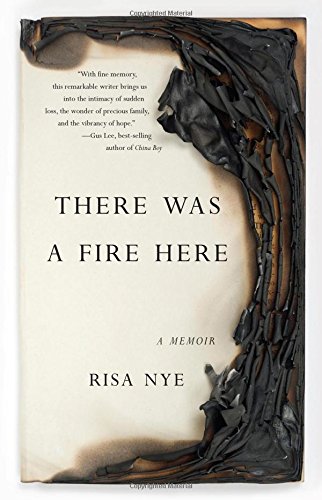Review by Vicki Mayk
 It was an unremarkable Sunday, Risa Nye writes. There were pancakes for breakfast, newspapers to be read, school projects, Disney videos and an early play date for one of her three children. Those moments of normalcy on October 20, 1991 did not last. Before the day was over, a wildfire would destroy Nye’s California home, reducing her family’s belongings to only what she loaded in her car as they fled the fire. That experience, and the months that followed, are chronicled in Nye’s memoir, There Was A Fire Here (She Writes Press 2016).
It was an unremarkable Sunday, Risa Nye writes. There were pancakes for breakfast, newspapers to be read, school projects, Disney videos and an early play date for one of her three children. Those moments of normalcy on October 20, 1991 did not last. Before the day was over, a wildfire would destroy Nye’s California home, reducing her family’s belongings to only what she loaded in her car as they fled the fire. That experience, and the months that followed, are chronicled in Nye’s memoir, There Was A Fire Here (She Writes Press 2016).
In the memoir’s introduction, aptly titled “Nothing,” Nye muses about what it means to lose everything. Forced by the fire to shed possessions, she likens the experience to the time when a trapeze artist flies from one bar to another. You’re suspended, she writes, between the thing you left and the thing you’re reaching for. Twenty-five years later, she says she misses the sense of lightness and freedom that followed losing all of her possessions – although she does not miss the sense of loss.
From this thoughtful beginning, Nye slips into a somewhat chronological narrative of the fire and the days, weeks, and months that follow. The book is structured into chapters detailing highlights – Halloween, the holidays, a fortieth birthday celebration – interspersed with sections titled “Artifacts.” After the well-articulated introduction musing on the freedom that comes from a lack of possessions, I found Nye’s memoir too often a recitation of “what happened next.” The chapters lacked the reflection promised in the introduction.
The artifacts sections tell stories of items – from an antique desk to a special blanket – lost in the fire. These are the most effective parts of the memoir, reminding us that belongings are just belongings. Their value lies in the memories they evoke and their meaning resides in the experiences and emotions that they represent.
Nye does a good job of sharing the stories behind these lost artifacts and we learn far more about her and her family from these sections than we do from some of the other chapters. In writing about them, she affirms that memory outlives the objects themselves. However, I kept waiting for her to return to her opening theme, to provide the reader with more insight gained from the experience. She never does – and if the memoir falls short, it’s in Nye’s failure to return to expand on her opening theme elsewhere in the narrative.
Nye’s writing style is clean and her prose never falters. She does a bit too much telling instead of showing us what happened in the months after the disaster. It’s almost as if she mistrusts her readers, insisting on telling us, for example, that she and her husband are “tired of being the grownups.” Yet her description of storming out of the house when her children are being uncooperative accomplishes the same thing – and does it better than stating the obvious. The book would have been stronger with less obvious commentary.
The memoir closes with a brief re-telling of the book’s inciting incident: what happened before, during, and after the blaze. And it is here that Nye returns to one of the memoir’s strongest themes: that a disaster changes people and places for good. With the simple act of wondering what happened to a favorite white tablecloth, she remembers, “There was a fire here.” By then, we have learned she will always carry the experience with her.
Women who have helped to hold their family together through challenges and loss will appreciate Nye’s matter-of-fact retelling of this life-changing event.
 Vicki Mayk is a memoirist and nonfiction writer. She has enjoyed a 35-year career in journalism and public relations and has edited college and university magazines, most recently for Wilkes University in Wilkes-Barre, Pa., where she earned an MFA and teaches classes about the power of story. Her nonfiction book in progress chronicles the life and death of a college football player who had CTE, the brain disorder caused by concussions and subconcussive hits. Visit her web site at www.vickimayk.com.
Vicki Mayk is a memoirist and nonfiction writer. She has enjoyed a 35-year career in journalism and public relations and has edited college and university magazines, most recently for Wilkes University in Wilkes-Barre, Pa., where she earned an MFA and teaches classes about the power of story. Her nonfiction book in progress chronicles the life and death of a college football player who had CTE, the brain disorder caused by concussions and subconcussive hits. Visit her web site at www.vickimayk.com.


